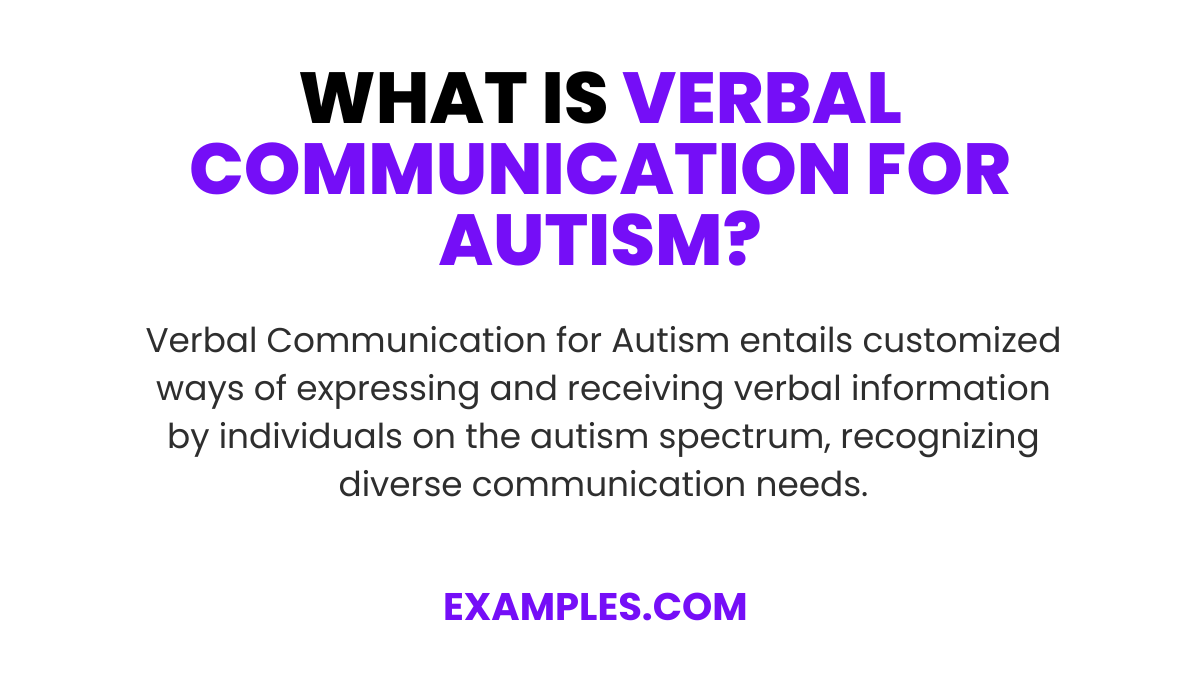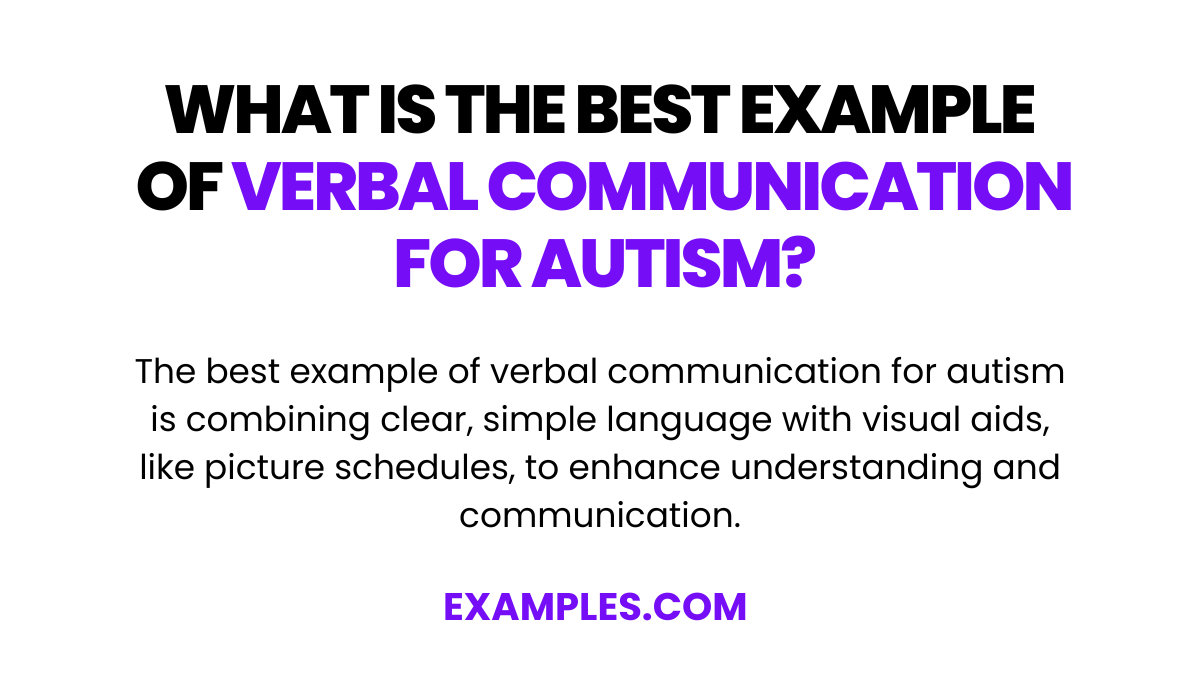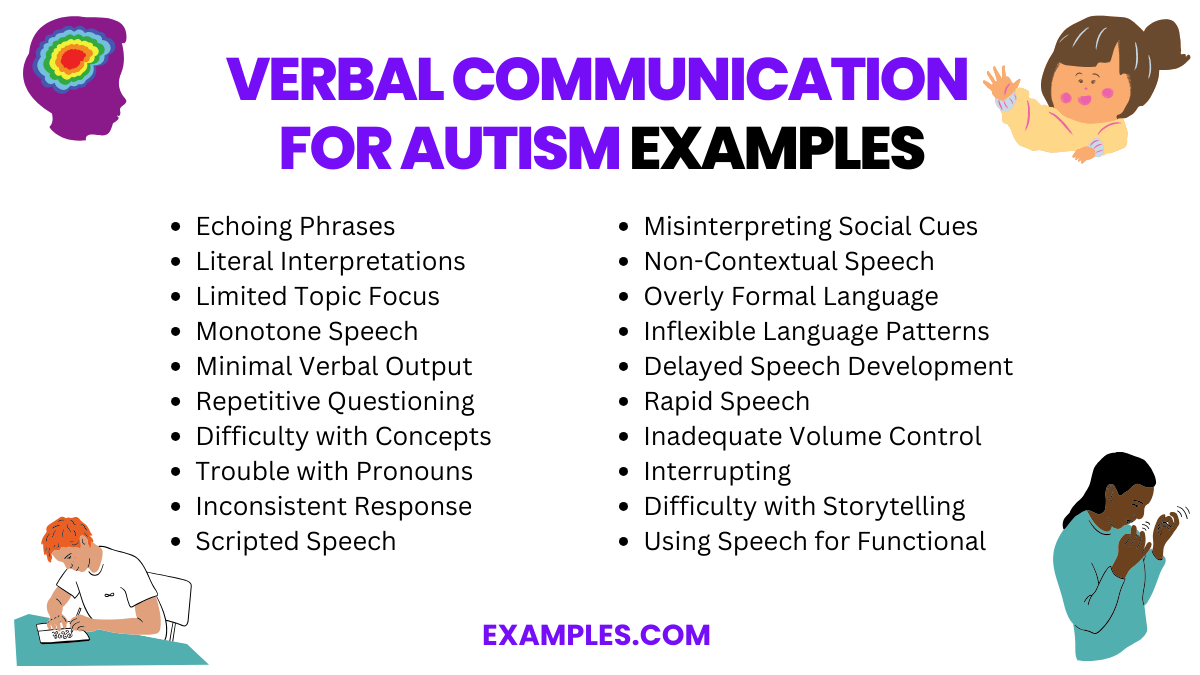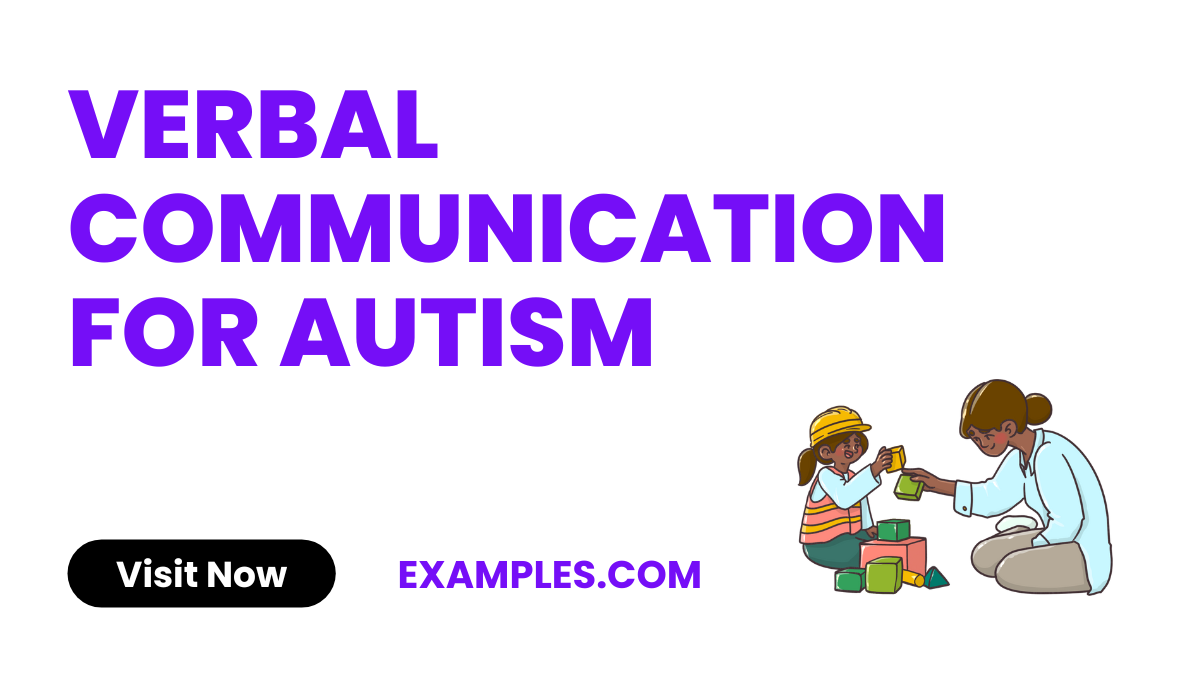Verbal Communication for Autism
Dive into the specialized world of Verbal Communication for Autism with this comprehensive guide. Understand through various Communication Examples how verbal interaction unfolds uniquely for autistic individuals. This guide aims to enlighten caregivers, educators, and peers about the strategies, challenges, and innovative approaches for enhancing communication, fostering understanding, and empowering those on the autism spectrum.
Download Autism Verbal Communication Strategies PDF
What is Verbal Communication for Autism? – Meaning

Verbal Communication for Autism refers to the tailored ways in which individuals on the autism spectrum express and receive verbal information. It encompasses a range of Verbal Communication Examples from direct speech to alternative methods like picture exchange or sign language. Understanding this helps in appreciating the diverse communication needs and abilities of autistic individuals, highlighting the importance of adaptability and support in fostering effective verbal interactions.
What is the Best Example of Verbal Communication for Autism?

One of the best examples of verbal communication for autism is the use of simple, clear language paired with visual supports. For instance, an educator might use a picture schedule to visually represent the sequence of daily activities alongside verbal instructions. This method helps in bridging the communication gap by catering to both verbal understanding and visual processing preferences, making it easier for autistic individuals to comprehend, anticipate, and participate in daily routines and conversations.
20 Verbal Communication for Autism Examples

Exploring the realm of verbal communication for autism reveals intricate dynamics. What Percent of Communication is Verbal? significantly varies in autistic individuals, making tailored approaches vital. Effective Verbal Communication Techniques are key, balancing between the unique Advantages and Disadvantages of Verbal Communication. Understanding the specific Functions of Verbal Communication in autism is essential, as it differs from typical development. This exploration encompasses various Types of Verbal Communication, each addressing diverse Verbal Communication Skills. Strategies on Ways to Improve Verbal Communication Skills are crucial, especially when comparing Verbal vs Written Communication and Verbal vs Oral Communication in autism.
- Echoing Phrases: Autistic individuals might repeat words or phrases, a phenomenon known as echolalia. This can be due to comfort in familiar sounds or difficulty in generating original speech. Improving this involves encouraging spontaneous language and providing context-based communication opportunities.
- Literal Interpretations: They often interpret language literally, leading to misunderstandings. To assist, use clear, direct language and explain idiomatic expressions.
- Limited Topic Focus: Some may speak extensively about preferred topics, struggling to switch topics. Enhancing social communication skills and gently guiding conversations to diverse subjects can be helpful.
- Monotone Speech: Lack of varied tone or expression in speech is common. Speech therapy can assist in teaching the nuances of tone and expression.
- Minimal Verbal Output: Some autistic individuals speak minimally or not at all. Alternative communication methods, like AAC devices, can aid in expression.
- Repetitive Questioning: This can stem from anxiety or a need for routine. Addressing underlying anxiety and providing structured responses can mitigate this.
- Difficulty with Abstract Concepts: Challenges in understanding abstract language can be aided by using concrete examples and visual supports.
- Trouble with Pronouns: Difficulty in using pronouns correctly is common. Teaching through modeling correct pronoun usage can help.
- Inconsistent Response to Verbal Cues: Responses to verbal instructions can be unpredictable. Consistent, clear, and simple instructions are beneficial.
- Scripted Speech: Using memorized phrases or dialogues from media instead of spontaneous language. Encouraging creative language use and role-playing can improve this.
- Misinterpreting Social Cues: Difficulty in understanding sarcasm or jokes. Explicit teaching of these social communication aspects is required.
- Non-Contextual Speech: Speaking about topics unrelated to the current situation. Teaching context recognition and practicing relevant conversation skills can be effective.
- Overly Formal Language: Using formal or old-fashioned language. Exposure to varied language styles and social scenarios can aid in developing a more natural speech style.
- Inflexible Language Patterns: Preference for certain words or phrases. Expanding vocabulary through reading and conversation can reduce this rigidity.
- Delayed Speech Development: Slower development of verbal skills. Early intervention and speech therapy can significantly aid in development.
- Rapid Speech: Speaking too quickly to be understood. Practicing pacing and speech exercises can help in moderating speech speed.
- Inadequate Volume Control: Issues with speaking too loudly or softly. Teaching and practicing volume control techniques can be beneficial.
- Interrupting or Talking Over Others: Challenges with turn-taking in conversation. Social stories and role-playing can teach appropriate conversational exchange.
- Difficulty with Storytelling: Struggling to narrate events in a logical sequence. Using visual aids and practicing storytelling can enhance this skill.
- Using Speech for Functional Purposes Only: Limited use of language for social interaction. Encouraging social use of language through games and social stories can broaden communication.
Verbal Communication for Autism in Adults
Description: Adults with autism navigate unique challenges in verbal communication, especially in structured settings such as the workplace, healthcare, and business environments. Enhancing Verbal Communication in the Workplace involves understanding and support from both employers and colleagues. In healthcare settings, clear and patient communication can significantly improve care for autistic adults, emphasizing the importance of Verbal Communication in Healthcare. Similarly, Verbal Communication in Business must be adapted to accommodate diverse communication needs, fostering an inclusive and understanding environment.
- Indirect Language in Meetings: Adults may struggle with indirect requests or implications in professional meetings. “John, please complete the report by Tuesday,” instead of hinting or using indirect speech.
- Overwhelm with Verbal Instructions: Information overload can be a barrier in fast-paced environments. “First, organize the files, then enter the data into the spreadsheet.”
- Difficulty in Social Nuances at Work: Misinterpretation of jokes or colloquial language can lead to confusion. “I’m joking,” or “This is important,” can clarify the context.
- Professional Language in Healthcare: Medical jargon can be confusing and alienating. “You have a mild infection and need antibiotics,” instead of using medical terminology.
- Formal Business Language: Complex business language can be a barrier in understanding and expressing ideas effectively. “Profit margin, which is the profit made from sales,” helps clarify business concepts.
What are the common challenges in verbal communication for autism?
Understanding the challenges in verbal communication is pivotal for effective teaching and learning, especially concerning Verbal Communication for Teachers and Verbal Communication for Students in educational settings.
- Literal Interpretation of Language: Autistic individuals might interpret language very literally, leading to misunderstandings or confusion about idiomatic expressions or jokes.
- Difficulty Understanding Non-Verbal Cues: Challenges in interpreting body language, facial expressions, and tone of voice can make communication complex and nuanced.
- Echolalia or Repetitive Speech: The tendency to repeat phrases or noises can interfere with meaningful language acquisition and conversation.
- Limited Use of Gestures: Autistic individuals might use fewer gestures to communicate, which can limit the expressiveness and effectiveness of their communication.
- Challenges with Topic Flexibility: Difficulty in shifting topics or engaging in a back-and-forth dialogue can hinder interactive communication.
What strategies can be employed to improve verbal communication for individuals with autism?
Enhancing verbal communication requires strategic approaches, such as those used in Verbal Communication for School environments, aimed at improving how individuals express and understand language.
- Use of Visual Supports: Visual aids like picture cards or storyboards can help in clarifying spoken language and providing a structure to communication.
- Encouraging Turn-Taking: Practicing conversation skills with activities designed to teach turn-taking can improve dialogic communication.
- Modeling and Prompting: Teachers and caregivers can model correct language use and prompt individuals to use language in specific ways during natural interactions.
- Technology Aided Communication: Devices and applications designed for augmentative and alternative communication can support those with limited verbal skills.
- Tailored Speech Therapy: Individualized speech therapy can address specific needs, focusing on both the expressive and receptive language skills.
What resources and tools are available to aid in verbal communication development for autism?
A variety of resources and tools, including those supporting Verbal Communication in Law Enforcement and methods on How to Improve Verbal Communication Skills, can be instrumental in developing effective communication for autistic individuals.
- Speech and Language Therapy: Professionally guided therapy is one of the most direct approaches to improving verbal skills, focusing on both understanding and producing language.
- Augmentative and Alternative Communication Devices (AAC): These tools can range from simple picture boards to sophisticated speech-generating devices, aiding those with significant speech challenges.
- Interactive Software and Apps: Specialized applications designed to encourage language development and social communication can be highly engaging and beneficial.
- Social Stories and Role-Playing: These techniques help in understanding and practicing appropriate social interactions and verbal exchanges.
- Communication Workshops and Training: Specialized workshops for caregivers, educators, and individuals can provide Communication Strategies and insights into effective Communication Methods and practices.
How do you encourage verbal communication in autism?
Encourage through consistent engagement, positive reinforcement, and tailored activities emphasizing the Importance of Verbal Communication in expressing needs and emotions effectively.
What are some signs of progress in verbal communication skills for individuals with autism?
Signs include increased vocabulary, better sentence structure, improved understanding and use of language, and more appropriate social language usage, highlighting Why you need Verbal Communication Skills.
What role does augmentative and alternative communication (AAC) play in supporting verbal communication for autism?
AAC tools provide alternative methods for effective communication, adhering to the Rules of Verbal Communication, especially for nonverbal individuals or those with speech difficulties.
Verbal communication for autism encompasses a spectrum of challenges and strategies. With tailored examples, understanding effects, recognizing signs, and employing effective remedies, individuals with autism can significantly enhance their communication skills. Embracing diverse methods and tools, including AAC, ensures a more inclusive and expressive future for those on the autism spectrum.



